Non-Destructive pXRF on Prehistoric Obsidian Artifacts from the Central Mediterranean
Abstract
:Featured Application
Abstract
1. Introduction
2. History of Obsidian
3. Analytical Methods
4. Obsidian Sourcing in Europe and the Mediterranean
5. Applications of pXRF on Obsidian Artifacts from Central Mediterranean Sites
5.1. Sardinian Obsidian in Continental Italy
5.2. Obsidian Artifacts from Sites around the Adriatic and in Croatia
5.3. The Small Island of Ustica, Northwest of Sicily
5.4. Obsidian at Sites in Malta
6. Discussion and Conclusions
Funding
Institutional Review Board Statement
Informed Consent Statement
Data Availability Statement
Acknowledgments
Conflicts of Interest
References
- Pliny the Elder (77 AD). Naturalis Historia Book 36. Chapter 67. Available online: http://www.perseus.tufts.edu/hopper/text?doc=Plin.+Nat.+toc (accessed on 1 August 2021).
- Tykot, R.H. Obsidian in prehistory. In Encyclopedia of Glass Science, Technology, History, and Culture; Richet, P., Ed.; John Wiley & Sons, Inc.: Hoboken, NJ, USA, 2021. [Google Scholar]
- Tykot, R.H. Obsidian studies in the prehistoric central Mediterranean: After 50 years, what have we learned and what still needs to be done? Open Archaeol. 2017, 3, 264–278. [Google Scholar] [CrossRef]
- Jacobsen, T.W. Excavation in the Franchthi Cave, 1969–1971, Part I. Hesperia J. Am. Sch. Class. Stud. Athens 1973, 42, 45–88. [Google Scholar] [CrossRef]
- Cann, J.R.; Renfrew, C. The characterization of obsidian and its application to the Mediterranean region. Proc. Prehist. Soc. 1964, 30, 111–133. [Google Scholar] [CrossRef]
- Belluomini, G.; Taddeucci, A. Studi sulle ossidiane italiane. III—Elementi minori. Period. Miner. 1971, 40, 11–39. [Google Scholar]
- Hallam, B.R.; Warren, S.E.; Renfrew, C. Obsidian in the western Mediterranean: Characterisation by neutron activation analysis and optical emission spectroscopy. Proc. Prehist. Soc. 1976, 42, 85–110. [Google Scholar] [CrossRef]
- Bigazzi, G.; Bonadonna, F.P.; Belluomini, G.; Malpieri, L. Studi sulle ossidiane italiane. IV. Datazione con il metodo delle tracce di fissione. Boll. Soc. Geol. Italy 1971, 90, 469–480. [Google Scholar]
- Michels, J.; Atzeni, E.; Tsong, I.S.T.; Smith, G.A. Obsidian hydration dating in Sardinia. In Studies in Sardinian Archaeology; Balmuth, M.S., Rowland, R.J., Jr., Eds.; University of Michigan: Ann Arbor, MI, USA, 1984; pp. 83–113. [Google Scholar]
- Birò, T.K.; Pozsgai, I.; Vlader, A. Electron beam microanalyses of obsidian samples from geological and archaeological sites. Acta Archaeol. Acad. Sci. Hung. 1986, 38, 257–278. [Google Scholar]
- Tykot, R.H. Prehistoric Trade in the Western Mediterranean: The Sources and Distribution of Sardinian Obsidian. Ph.D. Thesis, Department of Anthropology, Harvard University, Harvard, MA, USA, 1995. [Google Scholar]
- Williams-Thorpe, O. Obsidian in the Mediterranean and the Near East: A provenancing success story. Archaeometry 1995, 37, 217–248. [Google Scholar] [CrossRef]
- Tykot, R.H. Characterization of the Monte Arci (Sardinia) Obsidian Sources. J. Archaeol. Sci. 1997, 24, 467–479. [Google Scholar] [CrossRef]
- Tykot, R.H. Scientific methods and applications to archaeological provenance studies. In Physics Methods in Archaeometry. Proceedings of the International School of Physics “Enrico Fermi” Course CLIV; Martini, M., Milazzo, M., Piacentini, M., Eds.; Società Italiana di Fisica: Bologna, Italy, 2004; pp. 407–432. [Google Scholar]
- Tykot, R.H.; Glascock, M.D.; Speakman, R.J.; Atzeni, E. Obsidian subsources utilized at sites in southern Sardinia (Italy). In MRS Online Proceedings Library (OPL), Volume 1047: Symposium Y—Materials Issues in Art and Archaeology VIII; Vandiver, P.B., McCarthy, B., Tykot, R.H., Ruvalcaba-Sil, J.L., Casadio, F., Eds.; Cambridge University Press: Cambridge, UK, 2008; pp. 175–183. [Google Scholar]
- Le Bourdonnec, F.-X.; Bontempi, J.-M.; Marini, N.; Mazet, S.; Neuville, P.F.; Poupeau, G.; Sicurani, J. SEM-EDS characterization of western Mediterranean obsidians and the Neolithic site of A Fuata (Corsica). J. Archaeol. Sci. 2010, 37, 92–106. [Google Scholar] [CrossRef]
- De Francesco, A.M.; Crisci, G.M.; Bocci, M. Non-destructive analytical method by XRF for the determination of the provenance of archaeological obsidians from the Mediterranean area. A comparison with traditional XRF method. Archaeometry 2008, 50, 337–350. [Google Scholar] [CrossRef]
- De Francesco, A.; Bocci, M.; Crisci, G.M. Non-destructive applications of wavelength XRF in obsidian studies in X-ray fluorescence spectrometry (XRF) in geoarchaeology. In X-ray Fluorescence Spectrometry (XRF) in Geoarchaeology; Shackley, M.S., Ed.; Springer: New York, NY, USA, 2011; pp. 81–107. [Google Scholar]
- De Francesco, A.M.; Bocci, M.; Crisci, G.M.; Francaviglia, V. Obsidian provenance at several Italian and Corsican archaeological sites using the non-destructive X-ray fluorescence method. In Obsidian and Ancient Manufactured Glasses; Liritzis, I., Stevenson, C.M., Eds.; University of New Mexico Press: Albuquerque, NM, USA, 2012; pp. 115–130. [Google Scholar]
- Cecil, L.G.; Moriarty, M.D.; Speakman, R.J.; Glascock, M.D. Feasibility of field-portable XRF to identify obsidian sources in central Peten, Guatemala. In Archaeological Chemistry. Analytical Techniques and Archaeological Interpretation; Glascock, M.D., Speakman, R.J., Popelka-Filcoff, R.S., Eds.; American Chemical Society: Washington, DC, USA, 2007; pp. 506–521. [Google Scholar]
- Craig, N.; Speakman, R.J.; Popelka-Filcoff, R.S.; Glascock, M.; Robertson, J.D.; Shackley, M.S.; Aldenderfer, M.S. Comparison of XRF and PXRF for analysis of archaeological obsidian from southern Peru. J. Archaeol. Sci. 2007, 34, 2012–2024. [Google Scholar] [CrossRef] [Green Version]
- Ferguson, J.R. X-ray fluorescence of obsidian: Approaches to calibration and the analysis of small samples. In Handheld XRF for Art and Archaeology; Shugar, A.N., Mass, J.L., Eds.; Leuven University Press: Leuven, Belgium, 2012; pp. 401–422. [Google Scholar]
- Frahm, E. Validity of “off-the-shelf” handheld portable XRF for sourcing Near Eastern obsidian chip debris. J. Archaeol. Sci. 2013, 40, 1080–1092. [Google Scholar] [CrossRef]
- Frahm, E.; Doonan, R. The technological versus methodological revolution of portable XRF in archaeology. J. Archaeol. Sci. 2013, 40, 1425–1434. [Google Scholar] [CrossRef]
- Milic, M. PXRF characterisation of obsidian from central Anatolia, the Aegean and central Europe. J. Archaeol. Sci. 2014, 41, 285–296. [Google Scholar] [CrossRef]
- Tykot, R.H. Portable X-ray fluorescence spectrometry (pXRF). In The SAS Encyclopedia of Archaeological Sciences; López Varela, S.L., Ed.; John Wiley & Sons, Inc.: Hoboken, NJ, USA, 2018; pp. 1–5. [Google Scholar]
- Tykot, R.H. Using non-destructive portable X-ray fluorescence spectrometers on stone, ceramics, metals, and other materials in museums: Advantages and limitations. Appl. Spectrosc. 2016, 70, 42–56. [Google Scholar] [CrossRef]
- Tykot, R.H. A decade of portable (hand-held) X-ray fluorescence spectrometer analysis of obsidian in the Mediterranean: Many advantages and few limitations. Mrs. Adv. 2017, 2, 1769–1784. [Google Scholar] [CrossRef] [Green Version]
- Tykot, R.H. Investigating ancient “bronzes:” Non-destructive analysis of copper-based alloys. In Artistry in Bronze: The Greeks and Their Legacy. XIXth International Congress on Ancient Bronzes; Daehner, J.M., Lapatin, K., Spinelli, A., Eds.; The J. Paul Getty Museum and the Getty Conservation Institute: Los Angeles, CA, USA, 2017; pp. 289–299. [Google Scholar]
- Speakman, R.J.; Shackley, M.S. Silo science and portable XRF in archaeology: A response to Frahm. J. Archaeol. Sci. 2013, 40, 1435–1443. [Google Scholar] [CrossRef]
- Guthrie, J.M.; Ferguson, J.R. XRF Technical Overview. University of Missouri Research Reactor Archaeometry Laboratory, 2013. Available online: https://archaeometry.missouri.edu/xrf_technical.html (accessed on 1 August 2021).
- Lugliè, C.; Le Bourdonnec, F.-X.; Poupeau, G.; Bohn, M.; Meloni, S.; Oddone, M.; Tanda, G. A map of the Monte Arci (Sardinia island, Western Mediterranean) obsidian primary to secondary sources. Implications for neolithic provenance studies. Comptes Rendus Palevol 2006, 5, 995–1003. [Google Scholar] [CrossRef]
- Tykot, R.H. The sources and distribution of Sardinian obsidian. In Sardinia in the Mediterranean: A Footprint in the Sea. Studies in Sardinian Archaeology Presented to Miriam S. Balmuth; Tykot, R.H., Andrews, T.K., Eds.; Monographs in Mediterranean Archaeology; Sheffield Academic Press: Sheffield, UK, 1992; Volume 3, pp. 57–70. [Google Scholar]
- Tykot, R.H. Chemical fingerprinting and source-tracing of obsidian: The central Mediterranean trade in black gold. Acc. Chem. Res. 2002, 35, 618–627. [Google Scholar] [CrossRef] [PubMed]
- Tykot, R.H. Mediterranean Islands and Multiple Flows: The Sources and Exploitation of Sardinian Obsidian. In Method and Theory in Archaeological Obsidian Studies; Shackley, M.S., Ed.; Advances in Archaeological and Museum Science; Plenum: New York, NY, USA, 1998; Volume 3, pp. 67–82. [Google Scholar]
- Tykot, R.H.; Setzer, T.; Glascock, M.D.; Speakman, R.J. Identification and Characterization of the Obsidian Sources on the Island of Palmarola, Italy. Geoarchaeol. Bioarch. Stud. 2005, 3, 107–111. [Google Scholar]
- Tykot, R.H. Geological sources of obsidian on Lipari and artifact production and distribution in the Neolithic and Bronze Age central Mediterranean. Open Archaeol. 2019, 5, 83–105. [Google Scholar] [CrossRef]
- Tykot, R.H.; Iovino, M.R.; Martinelli, M.C.; Beyer, L. Ossidiana da Lipari: Le fonti, la distribuzione, la tipologia e le tracce d’usura. In Proceedings of the Atti del XXXIX Riunione Scientifica dell’Istituto Italiano di Preistoria e Protostoria: Materie prime e scambi nella preistoria italiana, Firenze, Italy, 25–27 November 2004; pp. 592–597. [Google Scholar]
- Francaviglia, V. Ancient obsidian sources on Pantelleria (Italy). J. Archaeol. Sci. 1988, 15, 109–122. [Google Scholar] [CrossRef]
- Tufano, E.; D’Amora, A.; Trifuoggi, M.; Tusa, S. L’ossidiana di Pantelleria: Studio di caratterizzazione e provenienza alla luce della scoperta di nuovi giacimenti. In Atti Della XXXIX Riunione Scientifica dell’Istituto Italiano di Preistoria e Protostoria; Istituto Italiano di Preistoria e Protostoria: Firenze, Italy, 2006; pp. 391–402. [Google Scholar]
- Tufano, E.; D’Amora, A.; Trifuoggi, M.; Tusa, S. L’ossidiana di Pantelleria: Studio di caratterizzazione e provenienza alla luce della scoperta di nuovi giacimenti. In Atti Della XLI Riunione Scientifica dell’Istituto Italiano di Preistoria e Protostoria; Istituto Italiano di Preistoria e Protostoria: Firenze, Italy, 2012; pp. 840–849. [Google Scholar]
- Tykot, R.H. Geochemical analysis of obsidian and the reconstruction of trade mechanisms in the Early Neolithic period of the western Mediterranean. In Archaeological Chemistry. Materials, Methods, and Meaning; Jakes, K., Ed.; ACS Symposium Series; American Chemical Society: Washington, DC, USA, 2002; pp. 169–184. [Google Scholar]
- Cattani, M.; Tosi, M.; Tusa, S. La carta archeologica di Pantelleria. Sperimentazione di metodo e nuove prospettive sull’evoluzione della complessità sociale e politica nelle isole del Mediterraneo centrale. In Proceedings of the Seminario di Scienze Antropologiche, Atti di I Convegno sulla Preistoria e Protostoria siciliana, Corleone, Italy, 17–20 July 1997; pp. 121–133. [Google Scholar]
- Renfrew, C.; Wagstaff, M. (Eds.) An Island Polity: The Archaeology of Exploitation in Melos; Cambridge University Press: Cambridge, UK, 1982. [Google Scholar]
- Birò, T.K. More on the state of art of Hungarian obsidians. Archeometr. Muh. 2018, XV, 213–224. [Google Scholar]
- Rosania, C.N.; Boulander, M.T.; Biro, K.T.; Ryzhov, S.; Trnka, G.; Glascock, M.D. Revisiting Carpathian obsidian. Antiquity 2008, 82, 318. [Google Scholar]
- Tykot, R.H. Prehistoric obsidian travel to and through central Italy. In Obsidian and the Sea: Evidence, Concepts and Social Implications of Its Maritime Transportation; Reepmeyer, C., Moutsiou, T., Eds.; Cambridge University Press: Cambridge, UK, 2021; in press. [Google Scholar]
- Tykot, R.H. Obsidian procurement and distribution in the central and western Mediterranean. J. Mediterr. Archaeol. 1996, 9, 39–82. [Google Scholar] [CrossRef] [Green Version]
- Tykot, R.H. New approaches to the characterization and interpretation of obsidian from the Mediterranean island sources. In Materials Issues in Art and Archaeology VI; Vandiver, P.B., Goodway, M., Druzik, J.R., Mass, J.L., Eds.; Materials Research Society: Warrendale, PA, USA, 2002; Volume 712, pp. 143–157. [Google Scholar]
- Tykot, R.H. Sourcing of Sardinian obsidian collections in the Museo Preistorico-Etnografico ‘Luigi Pigorini’ using non-destructive portable XRF. In L’ossidiana del Monte Arci nel Mediterraneo. Nuovi apporti sulla diffusione, sui sistemi di produzione e sulla loro cronologia. Atti del 5° Convegno internazionale (Pau, Italia, 27–29 Giugno 2008); Lugliè, C., Ed.; NUR: Ales, Italy, 2010; pp. 85–97. [Google Scholar]
- Foresta Martin, F.; Tykot, R.H. Characterization and provenance of archaeological obsidian from Pirozza-Spalmatore, a site of Neolithic colonization on the island of Ustica (Sicily). Open Archaeol. 2019, 5, 4–17. [Google Scholar]
- Tykot, R.H. Obsidian finds on the fringes of the central Mediterranean: Exotic or eccentric exchange? In Exotica in the Prehistoric Mediterranean; Vianello, A., Ed.; Oxbow Books: Oxford, UK, 2011; pp. 33–44. [Google Scholar]
- Tykot, R.H. Obsidian use and trade in the Adriatic. In The Adriatic, a Sea Without Borders: Communication Routes of Populations in 6000 BC; Visentini, P., Podrug, E., Eds.; Civici Musei di Udine, Museo Friulano di Storia Naturale: Udine, Italy, 2014; pp. 171–181, 224–225. [Google Scholar]
- Tykot, R.H.; Freund, K.P.; Vianello, A. Source analysis of prehistoric obsidian artifacts in Sicily (Italy) using pXRF. In Archaeological Chemistry VIII; Armitage, R.A., Burton, J.H., Eds.; American Chemical Society: Washington, DC, USA, 2013; pp. 195–210. [Google Scholar]
- Ammerman, A.J.; Polglase, C. New evidence on the exchange of obsidian in Italy. In Trade and Exchange in Prehistoric Europe; Oxbow Monograph; Scarre, C., Healy, F., Eds.; Oxbow Books: Oxford, UK, 1993; Volume 33, pp. 101–108. [Google Scholar]
- Tykot, R.H.; Ammerman, A.J. New directions in central Mediterranean obsidian studies. Antiquity 1997, 71, 1000–1006. [Google Scholar] [CrossRef] [Green Version]
- Freund, K.P.; Batist, Z. Sardinian obsidian circulation and early maritime navigation in the Neolithic as shown through social network analysis. J. Isl. Coast. Archaeol. 2014, 9, 364–380. [Google Scholar] [CrossRef]
- Tykot, R.H. Islands in the stream: Stone age cultural dynamics in Sardinia and Corsica. In Social Dynamics of the Prehistoric Central Mediterranean; Tykot, R.H., Morter, J., Robb, J.E., Eds.; Accordia Specialist Studies on the Mediterranean; Accordia Research Institute, University of London: London, UK, 1999; Volume 3, pp. 67–82. [Google Scholar]
- Tykot, R.H. Obsidian artifacts: Origin of the raw material. In Special Place, Interesting Times: The Island of Palagruža and Transitional Periods in Adriatic Prehistory; Forenbaher, S., Ed.; Archaeopress: Oxford, UK, 2018; pp. 84–87. [Google Scholar]
- Brown, K.A.; Tykot, R.H.; Muntoni, I.M. Obsidian in the Tavoliere, southeastern Italy—A first regional study. J. Archaeol. Sci. Rep. 2018, 20, 284–292. [Google Scholar]
- Ruka, R.; Galaty, M.; Riebe, D.; Tykot, R.H.; Gjipali, I.; Kourtessi-Philippakis, G. pXRF analysis of obsidian artifacts from Albania: Crossroads or cul-de-sac? J. Archaeol. Sci. Rep. 2019, 24, 39–49. [Google Scholar] [CrossRef]
- Tykot, R.H. Appendix I: Obsidian provenance. In Ustica I: The Results of the Excavations of the Regione Siciliana Soprintendenza ai Beni Culturali ed Ambientali Provincia di Palermo in Collaboration with Brown University in 1990 and 1991; Holloway, R.R., Lukesh, S.S., Eds.; Archaeologia Transatlantica; Brown University: Providence, RI, USA, 1995; Volume XIV, pp. 87–90. [Google Scholar]
- Foresta Martin, F.; Di Piazza, A.; D’Oriano, C.; Carapezza, M.L.; Paonita, A.; Rotolo, S.G.; Sagnotti, L. New insights into the provenance of the obsidian fragments of the island of Ustica (Palermo, Sicily). Archaeometry 2017, 59, 435–454. [Google Scholar] [CrossRef]
- Speciale, C.; Iovino, M.R.; Freund, K.; de Vita, S.; Larosa, N.; Battaglia, G.; Tykot, R.H.; Vassallo, S. Obsidian from the site of Piano dei Cardoni, Ustica (Palermo, Italy): New Insights on the Prehistoric Occupation of the Island. Open Archaeol. 2021, 7, 273–290. [Google Scholar] [CrossRef]
- Tykot, R.H.; Foresta Martin, F. Analysis by pXRF of prehistoric obsidian artifacts from several sites on Ustica (Italy): Long-distance open-water distribution from multiple island sources during the Neolithic and Bronze Ages. Open Archaeol. 2020, 6, 348–392. [Google Scholar] [CrossRef]
- Tykot, R.H. Obsidian lithics tested by XRF. In Tas-Silġ, Marsaxlokk (Malta) I: Archaeological Excavations Conducted by the University of Malta, 1996–2005; Ancient Near Eastern Studies; Bonanno, A., Vella, N.C., Eds.; Peeters: Leuven, Belgium, 2015; Supplement 48; p. 471. [Google Scholar]
- Trump, D. Skorba and the Prehistory of Malta; Oxford University Press: Oxford, UK, 1966. [Google Scholar]
- Malone, C.; Stoddart, S.; Bonnano, A.; Trump, D. (Eds.) Mortuary Customs in Prehistoric Malta: Excavations at the Brochtorff Circle at Xaghra (1987–94); McDonald Institute Monographs: Cambridge, UK, 2009. [Google Scholar]


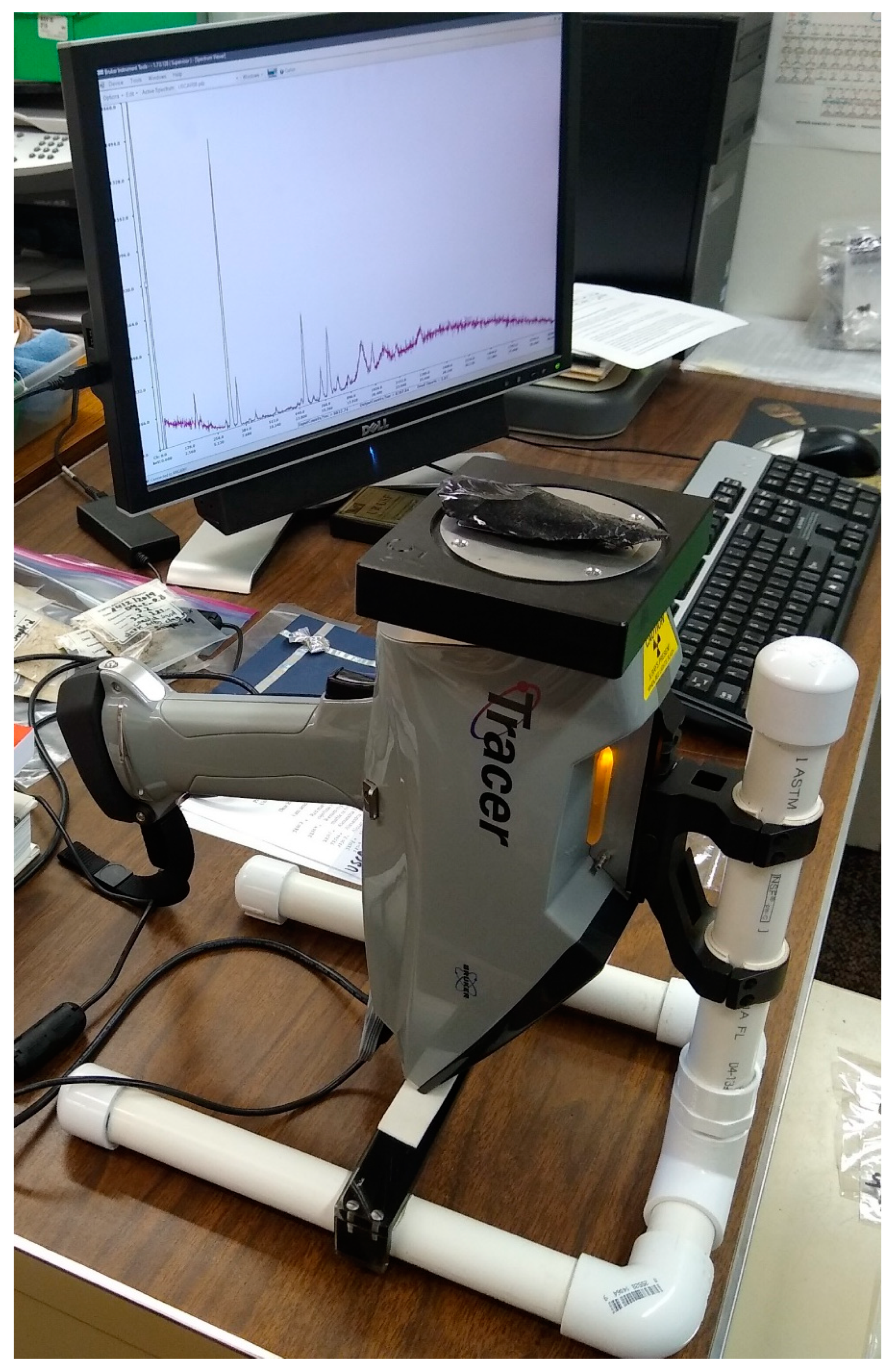
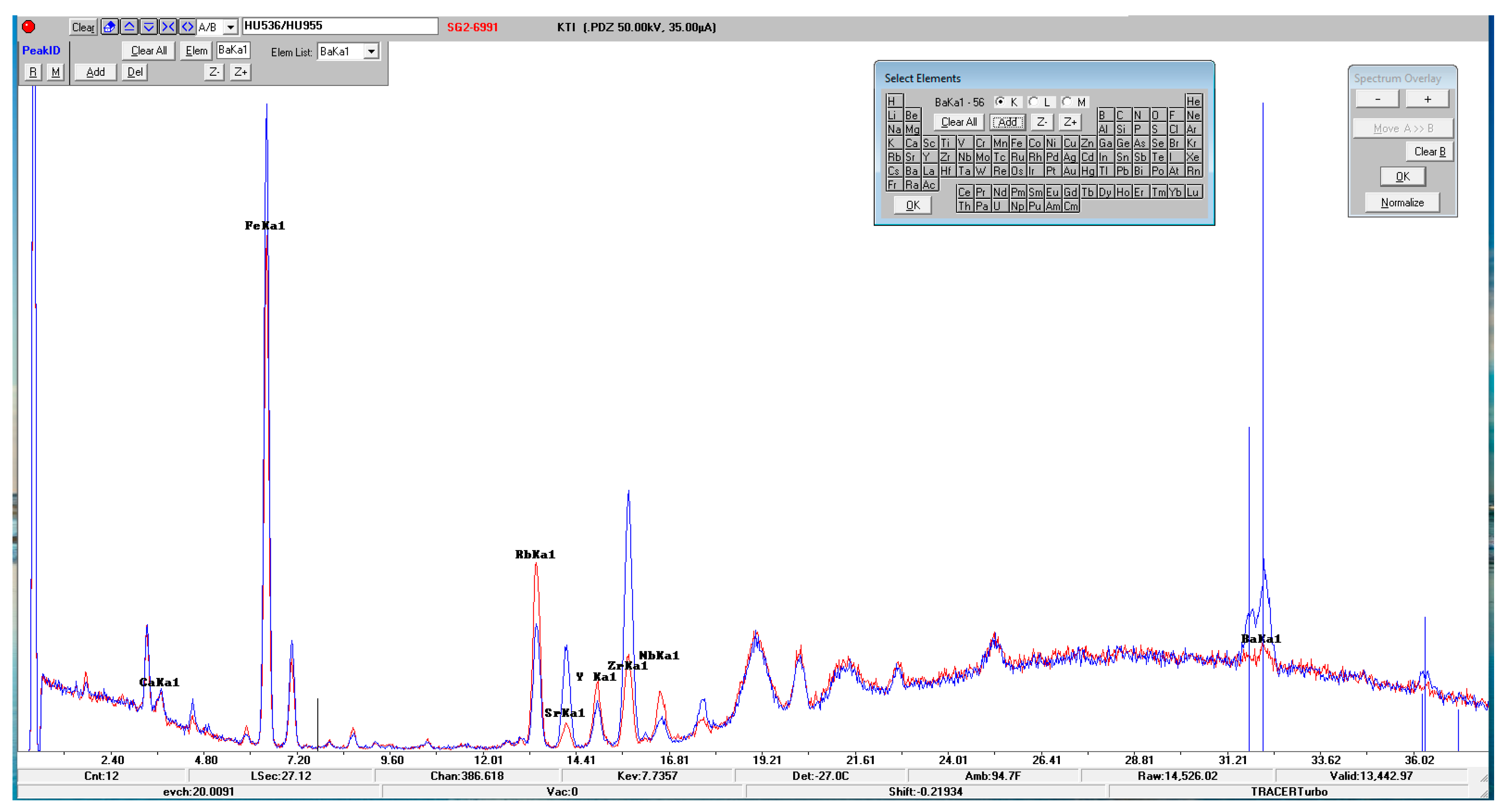
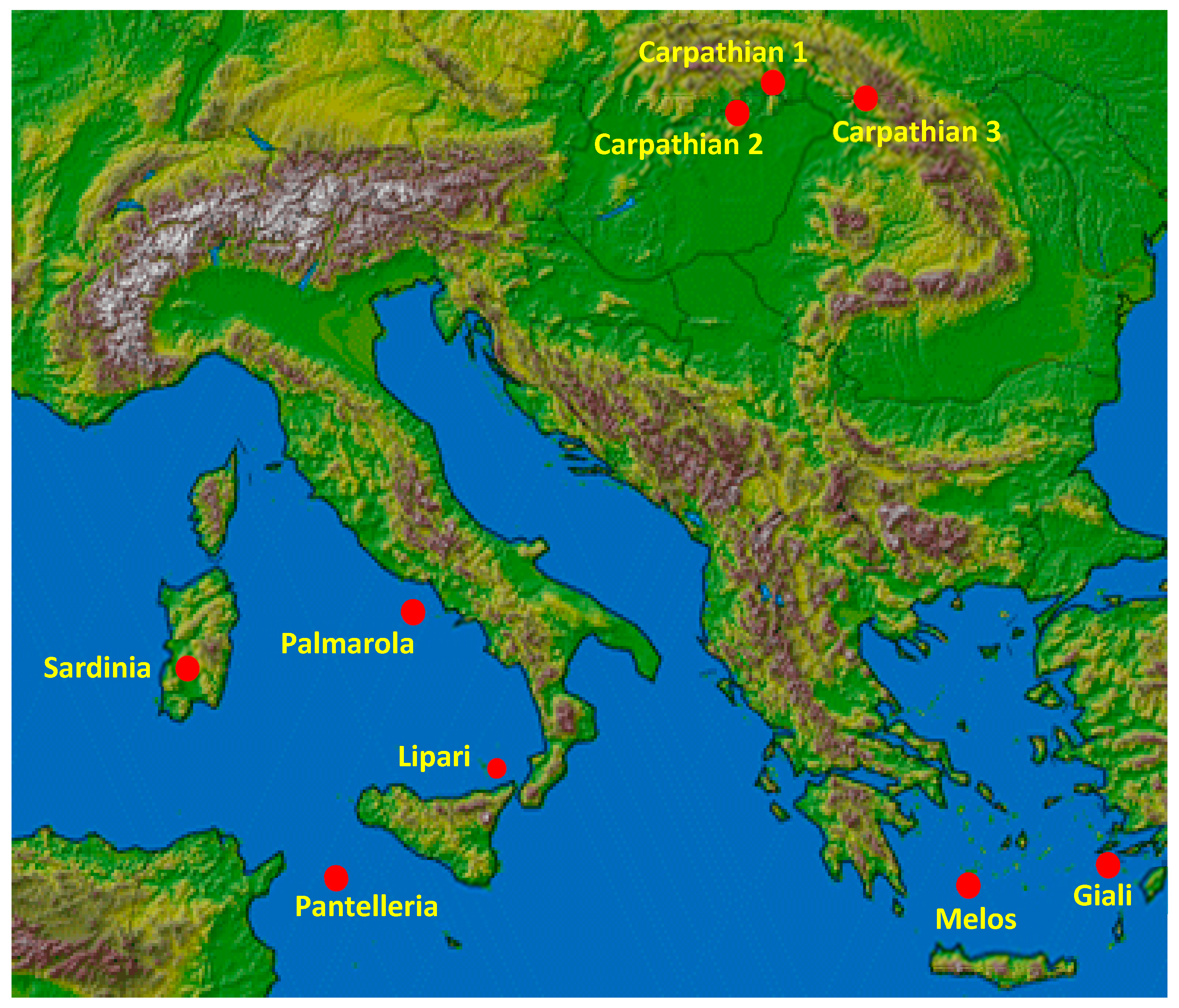

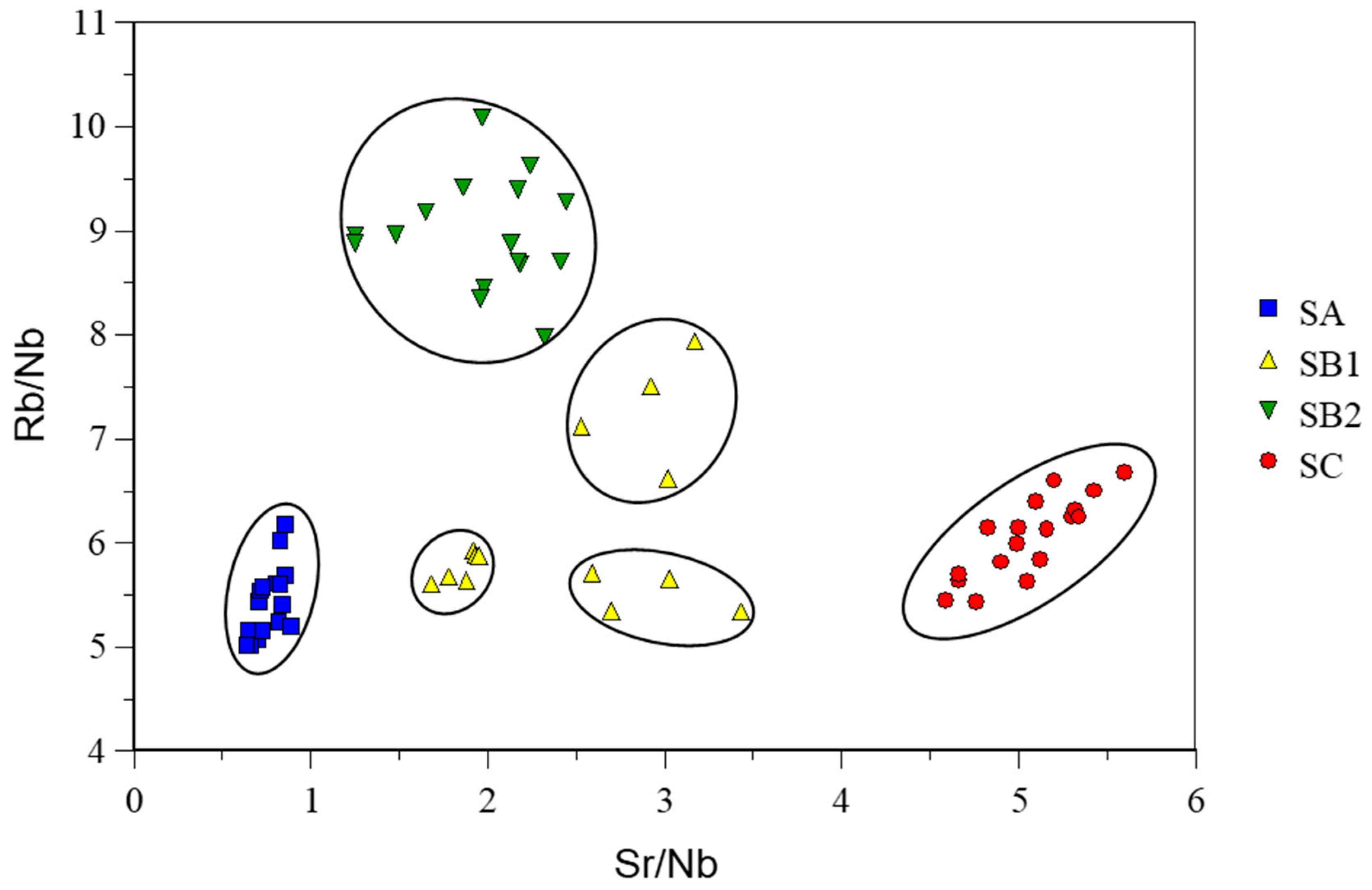
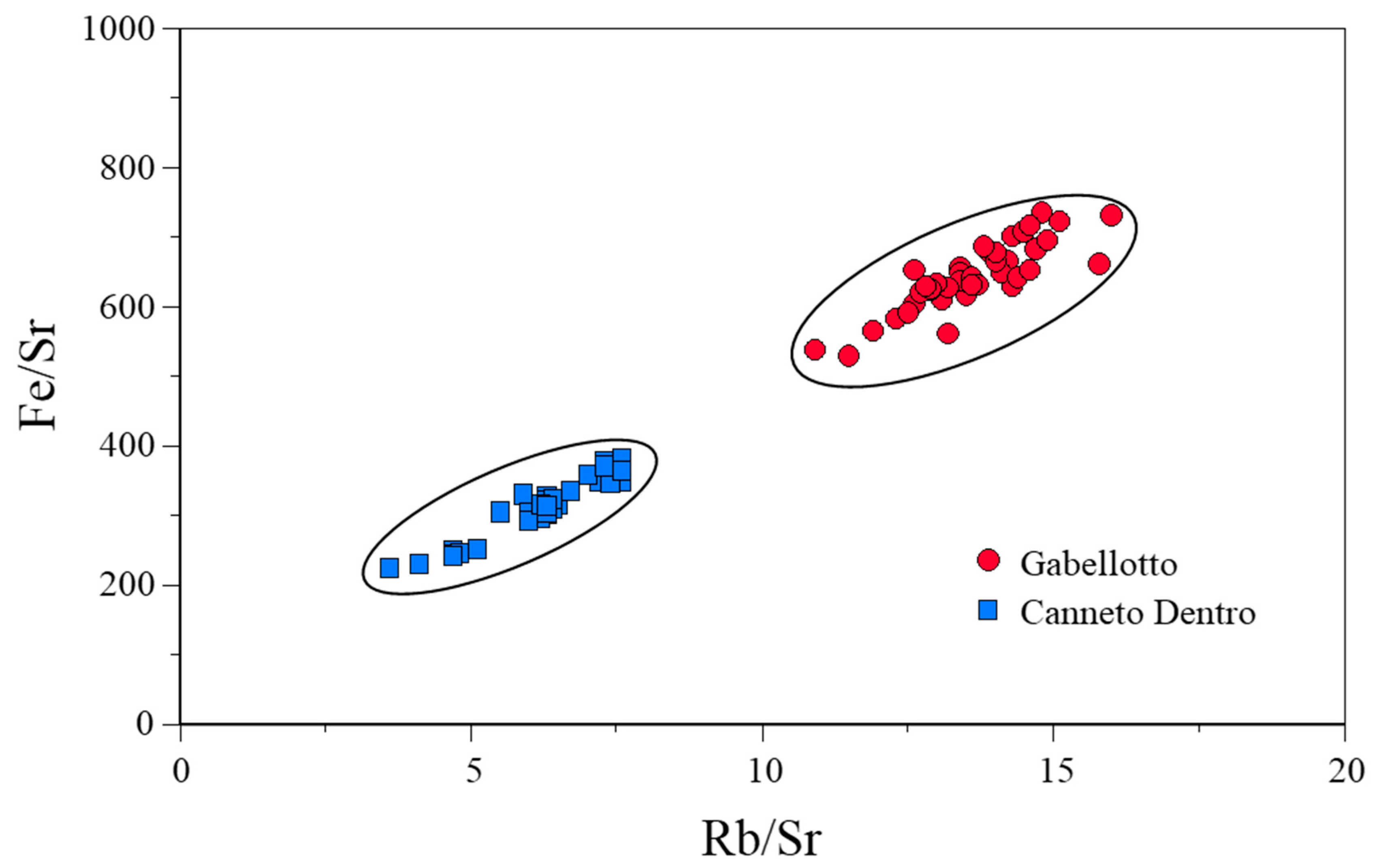
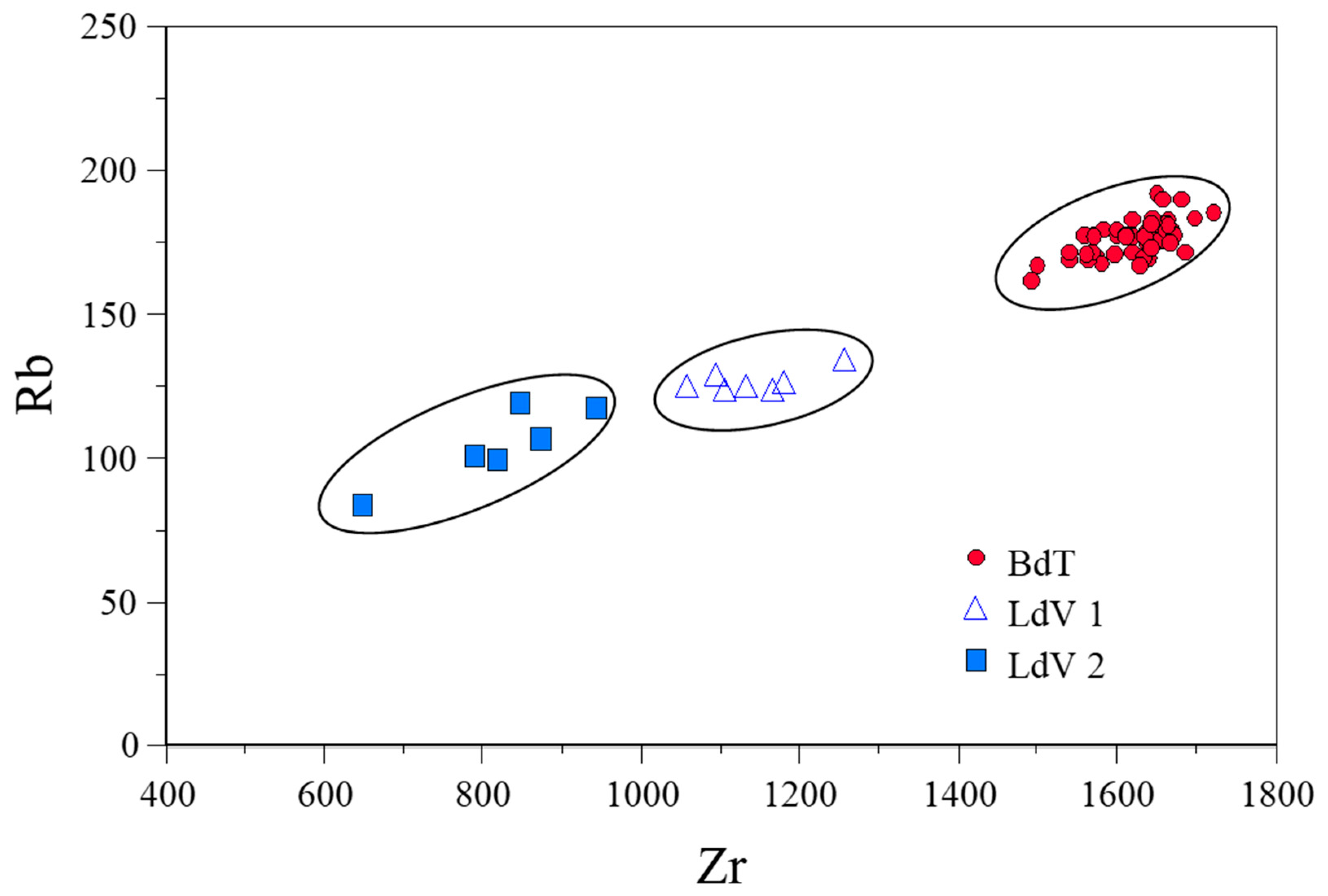
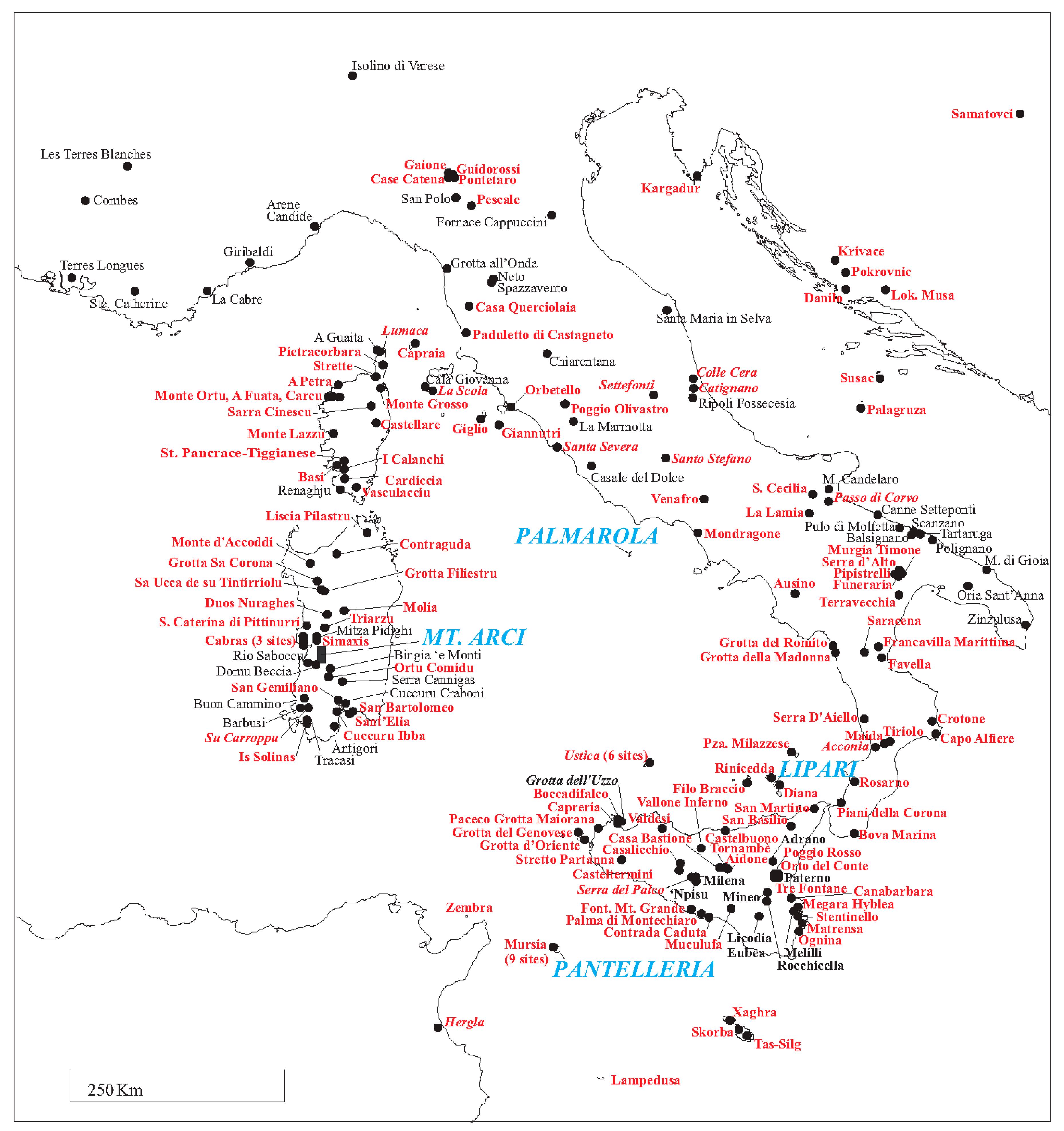
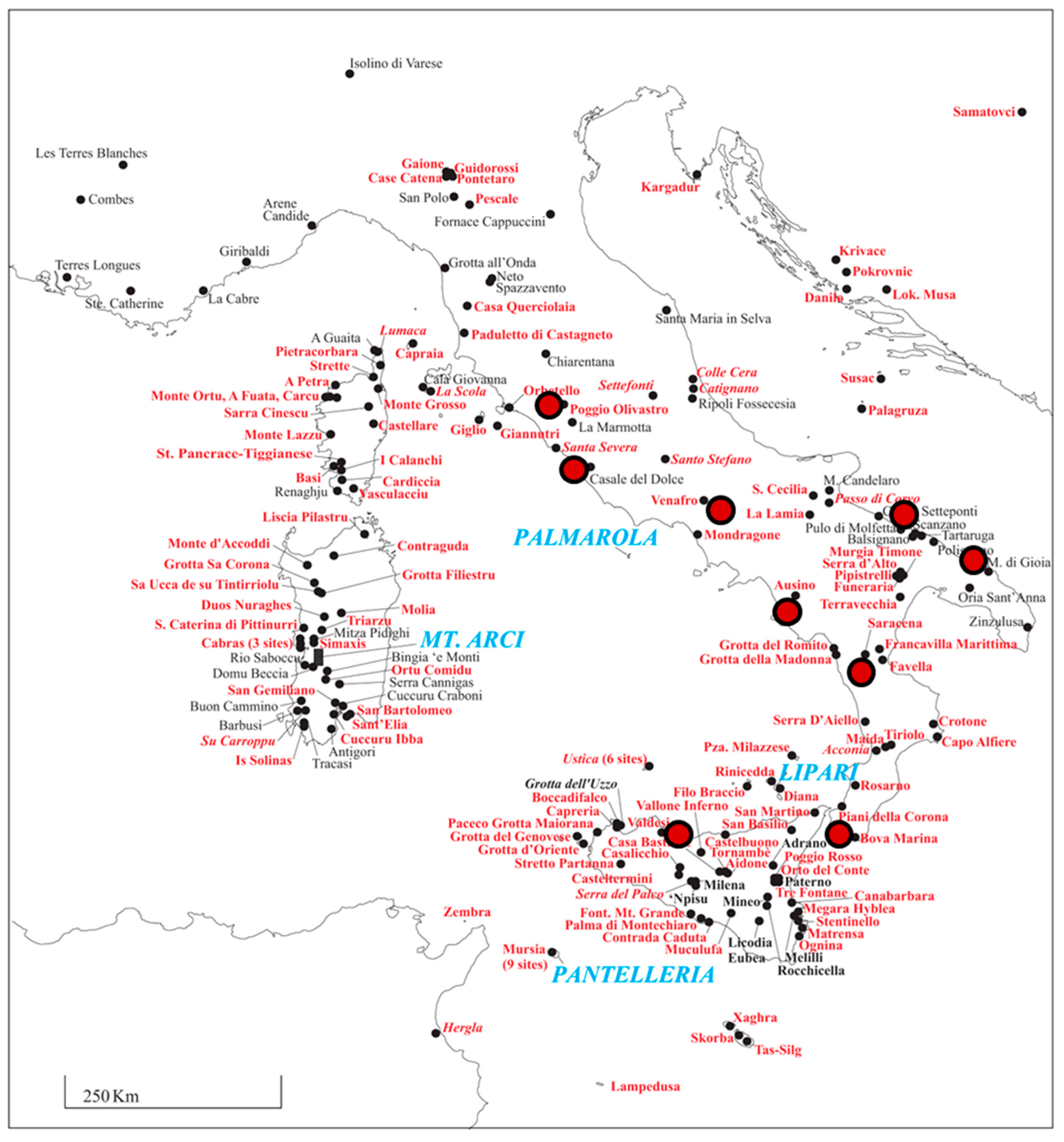
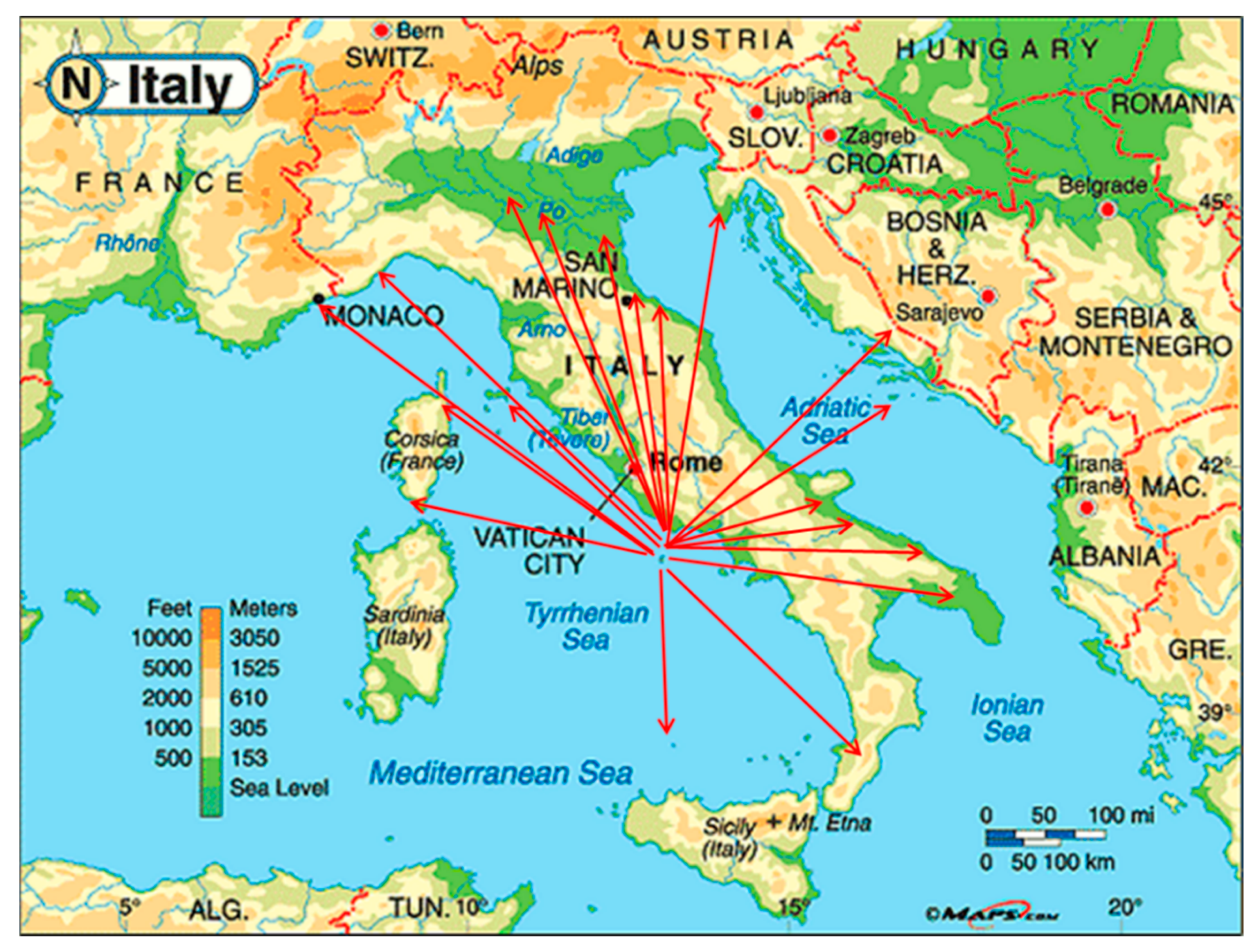
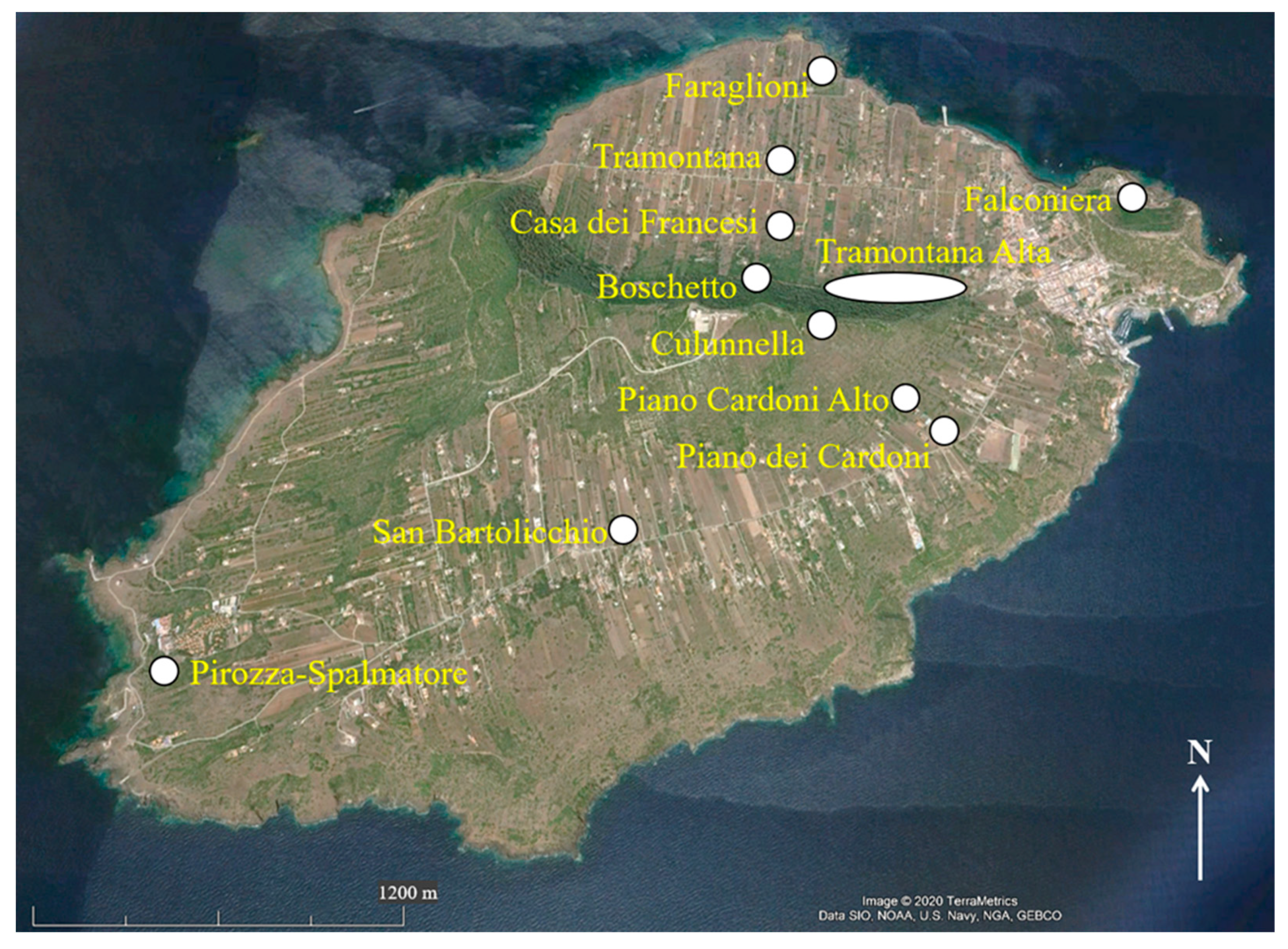
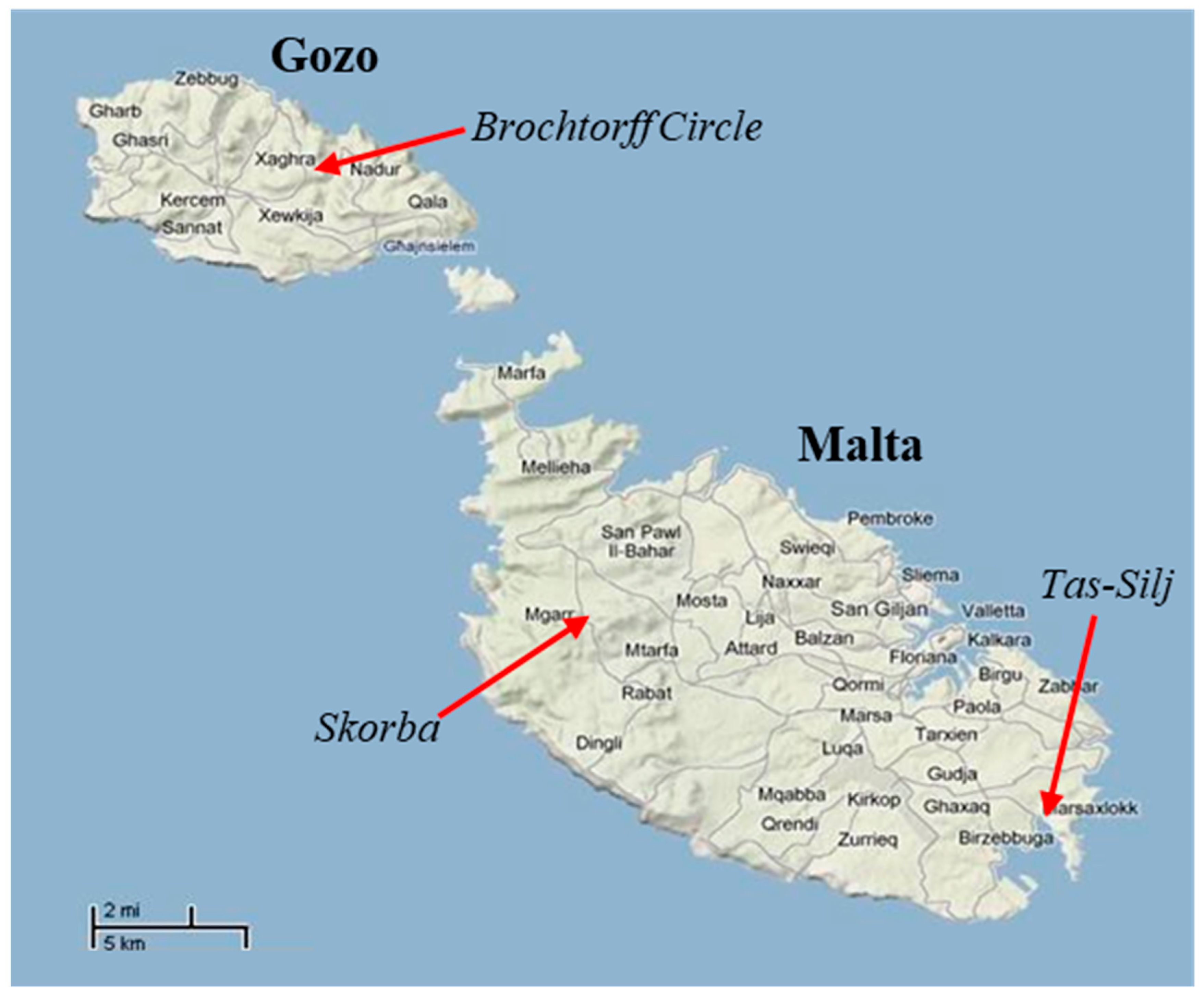

| Years | ≥10 Per Site | ≥25 Per Site | Analyses | % Total |
|---|---|---|---|---|
| 1964–1994 | 26 | 7 | 884 | 5% |
| 1995–2010 | 97 | 33 | 3217 | 19% |
| 2011–2021 | 158 | 108 | 12,895 | 76% |
| Total | 281 | 148 | 16,996 | 100% |
Publisher’s Note: MDPI stays neutral with regard to jurisdictional claims in published maps and institutional affiliations. |
© 2021 by the author. Licensee MDPI, Basel, Switzerland. This article is an open access article distributed under the terms and conditions of the Creative Commons Attribution (CC BY) license (https://creativecommons.org/licenses/by/4.0/).
Share and Cite
Tykot, R.H. Non-Destructive pXRF on Prehistoric Obsidian Artifacts from the Central Mediterranean. Appl. Sci. 2021, 11, 7459. https://doi.org/10.3390/app11167459
Tykot RH. Non-Destructive pXRF on Prehistoric Obsidian Artifacts from the Central Mediterranean. Applied Sciences. 2021; 11(16):7459. https://doi.org/10.3390/app11167459
Chicago/Turabian StyleTykot, Robert H. 2021. "Non-Destructive pXRF on Prehistoric Obsidian Artifacts from the Central Mediterranean" Applied Sciences 11, no. 16: 7459. https://doi.org/10.3390/app11167459
APA StyleTykot, R. H. (2021). Non-Destructive pXRF on Prehistoric Obsidian Artifacts from the Central Mediterranean. Applied Sciences, 11(16), 7459. https://doi.org/10.3390/app11167459






